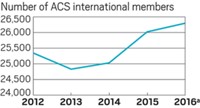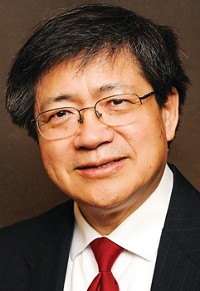Advertisement
Grab your lab coat. Let's get started
Welcome!
Welcome!
Create an account below to get 6 C&EN articles per month, receive newsletters and more - all free.
It seems this is your first time logging in online. Please enter the following information to continue.
As an ACS member you automatically get access to this site. All we need is few more details to create your reading experience.
Not you? Sign in with a different account.
Not you? Sign in with a different account.
ERROR 1
ERROR 1
ERROR 2
ERROR 2
ERROR 2
ERROR 2
ERROR 2
Password and Confirm password must match.
If you have an ACS member number, please enter it here so we can link this account to your membership. (optional)
ERROR 2
ACS values your privacy. By submitting your information, you are gaining access to C&EN and subscribing to our weekly newsletter. We use the information you provide to make your reading experience better, and we will never sell your data to third party members.
Policy
Innovations From International Collaborations
by H. N. Cheng, Chair, International Activities Committee
December 15, 2014
| A version of this story appeared in
Volume 92, Issue 50
Innovation is a major catalyst for economic growth. Certainly in chemistry, numerous innovative discoveries have been made over the years. U.S. chemical companies invested $56 billion in R&D to support new innovation in 2013, according to American Chemistry Council data. Moreover, 17% of U.S. patents are chemistry related.
Yet the global economy and research activities have evolved in the last 40 years. In 1970, the U.S. accounted for 27% of the world’s gross domestic product and published 32% of all scientific papers, but in 2013 it accounted for 22% of world GDP and published 21% of all scientific papers, according to data from the National Bureau of Economic Research and the U.K.’s Royal Society.
The chemical and related industries are certainly aware of these developments. The current trend for many companies is to engage in international collaboration. Collaboration can be intracompany or intercompany. Many companies have reorganized their internal R&D and analytical departments globally to maximize their effectiveness and to facilitate cooperation. Externally, collaboration can involve exchange of samples, information sharing, cooperative agreements, joint developments, or joint ventures. International collaborations can help innovation through increased speed of R&D, decreased cost, access to a greater talent pool, greater responsiveness to local markets and needs, and shared risks.
Furthermore, individual scientists and engineers can benefit from international collaborations. These are especially useful if there are complementary skills among the collaborators. Collaborations can entail division of labor in a project, use of particular equipment to facilitate research, and exchange of personnel. Collaborations can also facilitate the recruitment of talented students or postdoctoral fellows to work in an institute or a laboratory. In fact, more than 35% of scientific research articles today are the result of international collaborations among researchers from different countries, the Royal Society reports.
In view of these ongoing trends, the American Chemical Society has been active in promoting global networking, collaboration, and innovative endeavors. Currently, ACS has strategic alliances with the Chinese Chemical Society, Federation of Asian Chemical Societies, German Chemical Society, Latin American Federation of Chemical Associations, and South African Chemical Institute. ACS has also worked cooperatively with a number of other scientific organizations, such as the European Association for Chemical & Molecular Sciences, Federation of African Societies of Chemistry, and International Union of Pure & Applied Chemistry.
ACS has nine international chemical sciences chapters in Hong Kong, Hungary, Malaysia, Romania, Saudi Arabia, Shanghai, South Africa, South Korea, and Thailand. Among their many activities, the international chapters serve as bridges to different parts of the world and are excellent conduits to explore and forge collaborations.
In addition, ACS has a number of programs and services that can help individual members with international collaborations. The ACS International Center is a curated, Web-based repository of information about global science and technology opportunities. It includes listings of over 600 scientific collaboration and research opportunities from hundreds of funding organizations across 17 regions worldwide. The online monthly ACS International News gives useful information on current events, international meetings, regional news, resources, human rights, and other topics. At national meetings, we have hosted international receptions and international lounges to gather together meeting attendees with international interests. Moreover, we are involved in many multinational collaborative conferences, such as ACS Global Innovation Imperatives, Chemical Sciences & Society Summit, and Transatlantic Frontiers of Chemistry. The ACS Office of International Activities is instrumental in coordinating and ensuring the success of these activities.
In view of the ongoing trends and activities, the International Activities Committee organized a symposium titled “Innovation from International Collaborations” in San Francisco. Thirteen leaders from around the world discussed their perspectives and shared their experiences. They provided many examples of innovations and international collaborations in countries and regions such as Brazil, Haiti, India, Kenya, the Middle East, and Singapore.
Two examples are cited here: Sanjeev Katti, a senior vice president at Reliance (a huge petrochemical company in India), indicated that to support its businesses his company is investing in sponsored R&D, collaborations, and joint development programs with Indian and international universities, national labs, and large and small businesses worldwide. Peter Koelsch, a vice president at 3M, reported that his firm strives to derive over 30% of its sales from products introduced during the past five years. To accomplish this, effective sharing of technology, capabilities, and customer insights from around the globe is critical. These and many more presentations will be included in an upcoming ACS Symposium Series book on “Jobs, Collaborations, and Women Leaders of the Global Chemistry Enterprise.”
International collaborations represent a promising route to innovation, and ACS is offering many services in this regard. But we need help to better understand the role that the scientific professional society should play to serve its members and the chemical enterprise to foster and extend globally collaborative innovation in chemistry and allied fields. Please send your insights and suggestions to intlacts@acs.org.
Views expressed on this page are those of the author and not necessarily those of ACS.





Join the conversation
Contact the reporter
Submit a Letter to the Editor for publication
Engage with us on Twitter